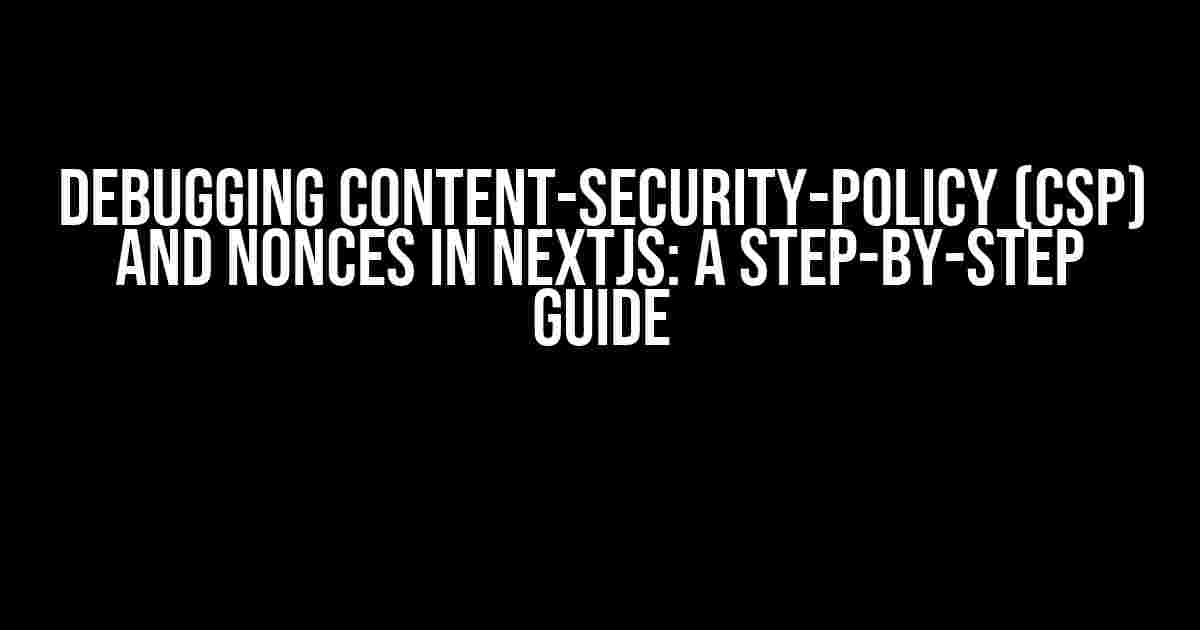Content-Security-Policy (CSP) is a powerful security feature that helps protect your NextJS application from cross-site scripting (XSS) attacks. However, implementing CSP can be challenging, especially when it comes to nonces. In this article, we’ll provide a comprehensive guide on how to debug CSP and nonces in NextJS.
Understanding CSP and Nonces
Before we dive into debugging, let’s quickly review what CSP and nonces are:
- CSP (Content-Security-Policy): A security feature that allows you to define which sources of content are allowed to be executed within a web page.
- Nonce: A one-time use token that is generated for each request and is used to validate the integrity of scripts and styles.
Common CSP and Nonce Issues in NextJS
Here are some common issues you may encounter when implementing CSP and nonces in NextJS:
- Blocked scripts and styles: Scripts and styles are blocked due to CSP restrictions.
- Nonce mismatches: Nonces generated by NextJS do not match the expected nonce values.
- Multiple nonce values: Multiple nonce values are generated for the same request.
Debugging CSP and Nonces in NextJS
To debug CSP and nonces in NextJS, follow these steps:
Step 1: Enable CSP in NextJS
In your `next.config.js` file, enable CSP by adding the following configuration:
module.exports = { //... experimental: { csp: { enabled: true, reportOnly: false, }, },}Step 2: Identify the Issue
Use the browser’s developer tools to identify the CSP issue. In the console, look for error messages related to CSP violations.
Step 3: Verify Nonce Generation
Check if NextJS is generating nonces correctly. In your `pages/_app.js` file, add the following code:
import { generateNonce } from 'next/dist/next-server/lib/utils'; const nonce = generateNonce(); console.log(nonce);This will generate a nonce value and log it to the console.
Step 4: Validate Nonce Values
Verify that the generated nonce value matches the expected nonce value in your CSP policy. In your CSP policy, add the following directive:
script-src 'nonce-{nonce}';Replace `{nonce}` with the generated nonce value.
Step 5: Review CSP Policy
Review your CSP policy to ensure it is correctly configured. Check for any typos, incorrect paths, or missing sources.
Conclusion
Debugging CSP and nonces in NextJS requires a systematic approach. By following these steps, you can identify and resolve common issues related to CSP and nonces. Remember to enable CSP in NextJS, identify the issue, verify nonce generation, validate nonce values, and review your CSP policy.
Frequently Asked Question
Debugging Content-Security-Policy (CSP) and nonces in NextJS can be a real headache. Don’t worry, we’ve got you covered! Here are some frequently asked questions to help you troubleshoot like a pro:
Q: How do I know if CSP is enabled in my NextJS app?
A: Check your `next.config.js` file for the `experimental.csp` option. If it’s set to `true`, CSP is enabled. You can also check your page’s HTML source code for a `` tag with a `content-security-policy` attribute. If you see it, CSP is on!
Q: Why am I getting a CSP error with a nonce mismatch?
A: This usually happens when the nonce in your HTML element doesn’t match the one in your CSP policy. Double-check that you’re generating a new nonce for each request and that it’s correctly injected into both your HTML and CSP policy. You can use the `nonce` option in `next.config.js` to configure nonce generation.
Q: How do I debug CSP issues in my NextJS app?
A: Enable CSP reporting by adding a `report-uri` directive to your CSP policy. This will send CSP violation reports to the specified URL. You can also use the browser’s DevTools to inspect the CSP policy and error messages. In Chrome, go to the Console tab and filter errors by “CSP” to see the policy and violations.
Q: Can I use a third-party library to generate nonces in my NextJS app?
A: Yes, you can! Libraries like `next-csp` and `cspnonce` can help generate and manage nonces for you. Just remember to configure them correctly and ensure they’re compatible with your NextJS version.
Q: How do I disable CSP for specific pages or components in my NextJS app?
A: You can use the ` UNSAFE_allowDangerousHtml` prop in your page or component to disable CSP for specific content. However, be cautious when using this approach, as it can compromise security. Alternatively, you can create a custom CSP policy for specific pages or components using the `next.config.js` file.


